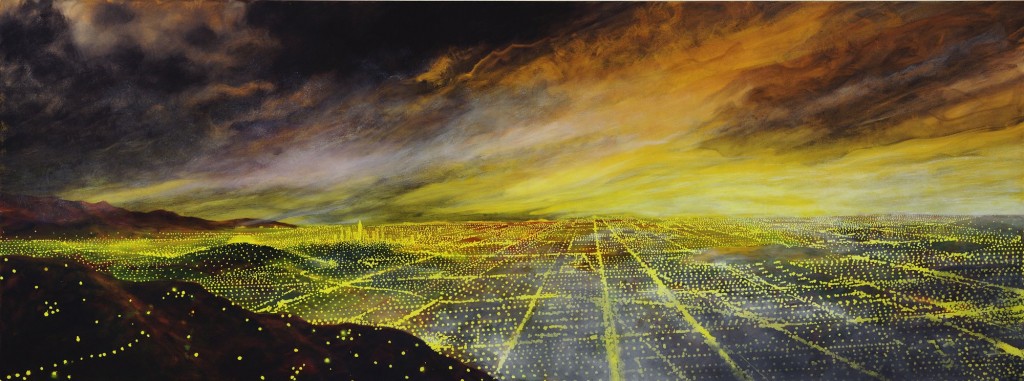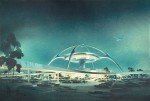Hundreds of tiny yellow dots illuminate Los Angeles’ sprawling streets and skyline as the sun sets. An outline of downtown and the city’s extensive freeways is visible against the darkening sky.
This image, a painting titled “PA and PE” by artist Peter Alexander, is one of several architectural drawings, photographs, models, artworks, films and interactive digital presentations on display in the Getty Museum’s newest exhibition, “Overdrive: L.A. Constructs the Future, 1940-1990.” The Getty Research Institute and the J. Paul Getty Museum collaborated to produce the exhibition, which offers a look into modern Los Angeles architecture during and after the city’s growth in the 20th century.
The exhibition, which was designed by the Getty Museum’s design department and students at the Art Center College of Design in Pasadena, Calif., is supplemented with a smaller exhibit, “In Focus: Ed Ruscha.” This collection of photographs and prints provides an in-depth look into L.A.-based artist and photographer Ed Ruscha’s photographic documents of the city’s buildings.
Rani Singh, senior research associate at the Getty Research Institute and a co-curator of the exhibition, said the interaction between artists and architects that is demonstrated in the main exhibition defines Los Angeles.
“The networks of the city are contractors and designers and artists and architects working together,” Singh said. “The ability to experiment and to investigate with new materials was something that was open in Los Angeles (during this time).”
Dell Upton, a professor of architectural history at UCLA, also said Los Angeles had a thriving arts and architecture scene in the second half of the 20th century. Architects often strayed from conventional architectural canons, making L.A. a center for experimental architecture.
“Los Angeles, especially (during) that period (of the late 20th century), had the reputation of being kind of out of the mainstream,” Upton said. “(Architects) cultivated that reputation when everyone else was looking at the East Coast.”
“Overdrive” traces these modern architectural developments in five categories: Car Culture, Urban Networks, Engines of Innovation, Community Magnets and Residential Architecture. The sections touch on everything from freeways to houses and cultural attractions like the Watts Towers and Disneyland.
The first section of the exhibition is dedicated to car culture, an aspect Singh said shapes the way people view Los Angeles. Images and drawings of gleaming automobiles, gas stations and roadside restaurants inspired by the new automobile and aerospace technologies of the time line the walls, while digital maps show the growth of the city in the 1940s.
The complementary exhibit “In Focus: Ed Ruscha” ties into this automobile theme. The car culture section itself contains photographs of building fronts by Ruscha, while the complementary exhibit features a selection of photographs and prints used in the production of Ruscha’s 1960s photobooks “Twentysix Gasoline Stations,” “Some Los Angeles Apartments” and “Every Building on the Sunset Strip.”
John Tain, assistant curator in Collection Development at the Getty Research Institute, said the photographs Ruscha took for these books, which range from gasoline stations along Route 66, apartment building facades and building fronts on the Sunset Strip respectively, show visitors the capabilities of street photography.
Ruscha set up a camera on the back of his car and took photographs of these architectural facades from the street, Tain said. For “Twentysix Gasoline Stations” and “Some Los Angeles Apartments,” Ruscha printed individual snapshots of these subjects, while he created a long, continuous, fold-out strip of photographs in the aptly titled “Every Building on the Sunset Strip.”
“(These books) continued this romance of the road or car culture,” Tain said. “(The photos for ‘Twentysix Gasoline Stations’) were taken … on the road back to L.A. and … what he’s doing here is showing us what car photography could do.”
Aside from the advent of car culture, the exhibition also delves into Los Angeles’ urban systems and centers of commerce, providing sketches and photographs of the city’s extensive freeway systems, the famous arched Theme Building at LAX and television studios in the Urban Networks and Engines of Innovation sections.
In “Community Magnets,” visitors can learn the stories behind some of L.A.’s most iconic attractions, including Dodger Stadium, Disneyland and the Walt Disney Concert Hall, designed by architect Frank Gehry.
The exhibition ends with a section featuring photographs and models of unconventional residential apartments and houses in L.A. Upton said Gehry, for example, revamped an ordinary house in Santa Monica by adding on walls with holes and jagged angles and using unconventional materials such as plywood and chain-link fences.
Upton said the “Overdrive” exhibition traces a history of multiple generations of architects and styles in Los Angeles.

“It’s a time of overlap. You have this sort of World War II generation of architects who were some of the first significant modern architects in California who were getting older and just beginning to die off,” Upton said. “At the same time, you have the current generation, the people who are the big architectural stars now, were (just) beginning at that time. So (the exhibition) gives you a kind of sense of that passing of the torch.”
